Phoenix Pix: November 2-6, 2009
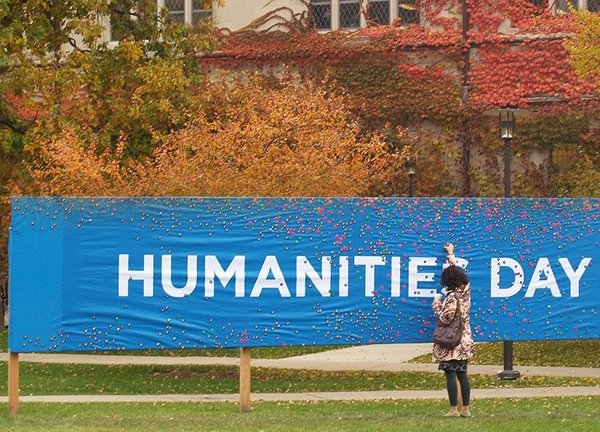
A passerby stops to pluck a pin from the Chicago Humanities Festival Day in Hyde Park board.
Photo by Barbara Palmer-Bostick.
Submit your best University of Chicago-themed photos to Phoenix Pix.
« October 2009 | Main | December 2009 »

A passerby stops to pluck a pin from the Chicago Humanities Festival Day in Hyde Park board.
Photo by Barbara Palmer-Bostick.
Submit your best University of Chicago-themed photos to Phoenix Pix.
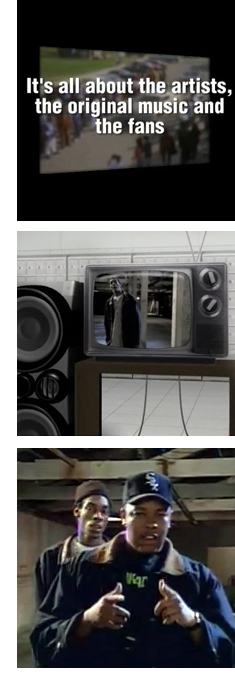 Lara Lavi, X’82, is a new-media/entertainment-law attorney, singer-songwriter, CEO of WIDEawake Entertainment Group, and a self-described “Jewish soccer mom.” Her eclectic résumé includes a BA in wildlife biology and natural-resource policy from the University of Michigan; a law degree, with a focus on environmental law, from the University of Oregon; legal work for the Muckleshoot Indian Tribe; and two solo albums, The Art of Living and Inside the Red Room.
Lara Lavi, X’82, is a new-media/entertainment-law attorney, singer-songwriter, CEO of WIDEawake Entertainment Group, and a self-described “Jewish soccer mom.” Her eclectic résumé includes a BA in wildlife biology and natural-resource policy from the University of Michigan; a law degree, with a focus on environmental law, from the University of Oregon; legal work for the Muckleshoot Indian Tribe; and two solo albums, The Art of Living and Inside the Red Room.
In April, Lavi helped guide WIDEawake’s purchase of the infamous rap label Death Row Records and its back catalog, which includes recordings by Tupac Shakur, Dr. Dre, and Snoop Dogg. It’s hard to imagine anyone more different from Death Row’s enormous and terrifying founder, Suge Knight, who, according to legend, once dangled rapper Vanilla Ice off a hotel balcony to get him to sign over rights to the song “Ice Ice Baby.”
Lavi recently spoke to UChiBLOGo's Carrie Golus, AB'91, AM'93, by phone.
Did you like gangsta rap when it first came out?
No. But I’ve grown to appreciate it, I will say that. Sort of.
No, I’m kidding. I appreciate all well-done forms of music. Am I the kind of person, demographically, that would gravitate towards gangsta rap? Probably not. I don’t think I should fool anybody or myself on that point.
People ask me all the time, what were you thinking? This is music that relates to gang violence, mistrust of the police, and misogyny. I have had to give this tremendous thought.
On a business level, this is an asset that is continually generating significant income. And on a substantive level, I’ve come to realize that a lot of this music in many ways is protest music. You have to peel back the swearing and understand that these guys were trying to find a way to align. They were trying to express the fact that they do not feel part of mainstream society. This was alternative socioeconomic folk music in some degree.
How did your company end up acquiring Death Row?
I was recruited in 2005 to evaluate the viability of a new-breed entertainment company that cross-collateralized its divisions of music, film, production, and technology. About a year ago I got the green light to acquire a significant asset. And quite to my surprise, we publicly bid $18 million for Death Row and not a penny over that, and we were the winners.
Now in retrospect, I can see why people were reticent to acquire this asset. The books and records were in very poor order. But the biggest challenge has been trying to figure out a way to work with the artists, because they’re very hostile toward the brand at this point. They never got paid royalties under Suge Knight. He basically kept all the money, I guess. I still don’t really understand what he did.
Our practice is to pay royalties and have excellent relationships with artists. I could never live with myself if we were doing things that were disreputable. Amazingly, I thought the most difficult relationship was going to be with the Tupac Amaru Shakur estate, and as it turns out, it is our absolute best relationship. [Shakur, one of the best-selling hip-hop artists of all time, died in 1996 at age 25.] That’s 50 percent of our income.
Are there upcoming Tupac projects?
Yes. We’re entitled, as per the court documents, to 13 unreleased Tupac compositions. We’re going to put those out in June 2010. That’s the goal. And Afeni Shakur [Tupac’s mother] is trusting me with the creative control of it. I intend benchmark production value on All Eyez on Me, one of Tupac’s best-selling albums, which I think will make fans happy, because they’re looking for pure Tupac. We’re trying to honor Tupac and what he intended.
Tupac also wrote a screenplay for a film, Live 2 Tell, when he was in prison. I’m looking for ways that we can option that. The script is fabulous.
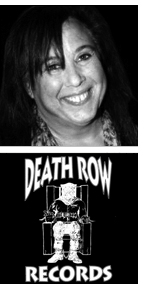
What was your time at the University of Chicago like?
I loved the academic experience, absolutely loved it. I have very fond memories of my Chicago days. I realize now I was very privileged to take economics classes, which have helped me greatly in my business.
I was getting good grades, fulfilling all the requirements, but for financial reasons I had to drop out. I started working as a waitress at the Kingston Mines Blues Bar. By the time I was done, I was singing with [Chicago blues legend] Jimmy Johnson, who’s 80 now. He used to drive me home to Hyde Park on his way back to Harvey, and sing me blues licks and teach me blues inflection.
How did you end up working for an Indian tribe?
With my science and environmental background, the obvious job if you want to stay pure—not end up on the polluters’ side—is to work for one of the tribes. So I ended up working for the Muckleshoot. I think I was making all of $18,000 a year.
Working for the tribe was a huge influence on me. I would periodically go to powwows, and spend time with elders. I ended up forming a group called the Songcatchers with a very dear friend of mine, Charles Neville, the saxophonist for the Neville Brothers. The group merged rock with full-on Indian powwow singing and drumming. That project toured all over the place, with Peter Gabriel and the Neville Brothers.
What kind of music do you like to listen to?
Anybody that knows me knows that I am a die-hard and absurdly neurotic Bruce Springsteen fan. I have no apologies. Bruce, if you’re out there, and you’re reading the University of Chicago alumni blog, I love you. I will always love you.
 "We've got better bells than Notre Dame," Elizabeth Davenport, dean of Rockefeller Memorial Chapel, says, citing one reason Rockefeller gets more visitors each year. With the tower reopened after renovations last year, and increased arts programming, she expects 150,000 people to come through the chapel's doors this year, triple 2006's crowds.
"We've got better bells than Notre Dame," Elizabeth Davenport, dean of Rockefeller Memorial Chapel, says, citing one reason Rockefeller gets more visitors each year. With the tower reopened after renovations last year, and increased arts programming, she expects 150,000 people to come through the chapel's doors this year, triple 2006's crowds.
If you haven't popped into Rockefeller since hearing the Aims of Education address as a first-year, here are some ways to make a virtual visit:
 From the end of World War II until the summer of 1961, more than 3.5 million East Germans—20 percent of the population—fled the Soviet bloc nation. Their main escape path led from East to West Berlin. Something had to be done, the Soviets agreed, and that something began as a wire fence encircling West Berlin.
From the end of World War II until the summer of 1961, more than 3.5 million East Germans—20 percent of the population—fled the Soviet bloc nation. Their main escape path led from East to West Berlin. Something had to be done, the Soviets agreed, and that something began as a wire fence encircling West Berlin.
From fence to reinforced fence to concrete, the wall grew by 1980 to two massive fortifications, with a swath of barren land (aka the Death Zone) in between. Walls, armed guards, dogs, watchtowers, beds of nails, and other deterrents worked. Between 1961 and November 9, 1989, when the wall fell, only 5,000 East Germans attempted to escape.
That’s the human perspective. But a 2009 German-Polish documentary film, shown at International House last week as part of a three-day series marking the 20th anniversary of events that led to the end of the cold war, takes a rabbit’s-eye view.
Rabbit à la Berlin (in Polish, Królik po berlinsku) begins in the burned-out aftermath of post-war Berlin, as rabbits flock to makeshift gardens sown near Potsdamer Platz. Times are hard, but the gardens and the rabbits take it day by day. Years go by, and the rabbits wake one morning to the fence, to the wall, and then to the realization that they can't get out. But the basic necessities of life remain, and so the rabbits multiply. They believe the guards are there to protect them, and they are content. Until some aren’t. When they begin to burrow their way out, they become the hunted.
Through newsreel clips, we watch as the rabbits watch builders, guards, escapees, statesmen, tourists—and the wall itself—come and go. The archival and contemporary footage of the rabbits is equally revealing. But if Rabbit à la Berlin (up for a 2010 Academy Award nomination in the documentary short-subject category) follows the conventions of a nature documentary, its subject is human nature.
On the surface, the commentary is serene; underneath, hardly safe: “…for rabbits, this was almost like a zoo...” or “there would be individuals that would go against the herd….” The rabbits are not the only species still struggling to adjust to life after the wall.
Mary Ruth Yoe
"With Immediate Effect" The Events of 1989 Revisited
A film and discussion series reflecting on the 20th anniversary of the transitions in Central and Eastern Europe that marked the end of the cold war and altered the balance of power in the world. The Center for International Studies series was cosponsored by the International House Global Voices Program, Doc Films, and the Center for East European and Russian/Eurasian Studies.

Architects Tod Williams and Billie Tsien recently unveiled detailed plans for the Reva and David Logan Center for Creative and Performing Arts. Construction begins this winter.
Artwork by Williams and Tsien.
Submit your best University of Chicago-themed photos to Phoenix Pix.
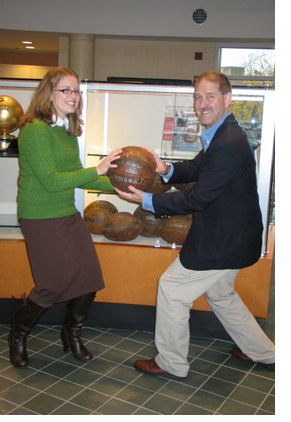 At an October 30 ceremony at Ratner Athletic Center, NASA astronaut John Grunsfeld, SM'84, PhD'88, returned the basketball used by Edwin Hubble, SB 1910, PhD 1917, and his teammates on the 1908-1909 Big Ten championship team. Grunsfeld had carried the ball aboard the space shuttle Atlantis on NASA’s final mission to service the Hubble Space Telescope. Theresa Ebenhoeh, a development associate with the Physical Sciences Division, managed to get herself in this curious picture with Grunsfeld after the ceremony. Here’s how it came about, in her own words:
At an October 30 ceremony at Ratner Athletic Center, NASA astronaut John Grunsfeld, SM'84, PhD'88, returned the basketball used by Edwin Hubble, SB 1910, PhD 1917, and his teammates on the 1908-1909 Big Ten championship team. Grunsfeld had carried the ball aboard the space shuttle Atlantis on NASA’s final mission to service the Hubble Space Telescope. Theresa Ebenhoeh, a development associate with the Physical Sciences Division, managed to get herself in this curious picture with Grunsfeld after the ceremony. Here’s how it came about, in her own words:
“John Grunsfeld was being interviewed by a writer for the Chicago Maroon while [Assistant Athletic Director] Dave Hilbert, Steve Koppes [of the News Office], and I were cleaning up. Dave had his camera, so when the interview was finished, I asked John if I could have my picture taken with him. He said yes, and went to the display case, unlocked it, and took the ball out. Dave shot a couple of pictures, and then he said, ‘Let’s do a jump ball!’”
The picture speaks for itself. (Ebenhoeh is the one on the left, without the mustache.)
Benjamin Recchie, AB’03
On Monday morning I bustled about my apartment, throwing gym clothes into a bag. “What’s going on?” asked my husband. “I’m going to gymnastics practice at the U of C.” Long pause: “OK…Be careful, Katie. You haven’t done gymnastics since you were 18.” A former gym rat who misses flipping, I had perused the Web site of the Gymnastics Club—an RSO that welcomes students, faculty, and staff—but never worked up the nerve to attend a practice. I decided it was time to take the plunge.
That evening I entered the gymnastics room in Lab’s Kovler Gym. It’s a cozy space packed with 80s-era gymnastics equipment: wooden balance beams, stiff uneven bars, a vaulting horse instead of the modern vaulting table. Settling onto a blue mat, I watched the club president, College third-year Joe Cacioppo, lead 11 male and female members through a warm-up of tuck jumps, stretches, bridges, and splits. Then Cacioppo, a former competitive gymnast and coach, announced the start of tumbling practice. With Bon Jovi blaring in the background, the gymnasts performed handstands, walkovers, and front and back handsprings up and down the yellow tumbling strip.
After tumbling, participants split up to work on different pieces of apparatus. Brian Callender, AB’97, AM’98, MD’04, an assistant professor of medicine who was a gymnast in high school and joined the club last year, breezed through a killer pommel-horse sequence of circles and flares, while Cacioppo whirled around the high bar, bending his knees to avoid the low ceiling. “I did that last year," said Callender, "hit the ceiling and sliced my knee."
The industrious atmosphere inspired me, albeit just a little. As I swung on the bars, the muscles in my stomach ached. Walking across the beam, I completed some of the basic dance moves from my old high-school routine. I decided to call it a day and wondered: how did I ever do this? “You can get it back,” Callender told me. “It just takes time.” Hey, why not? Maybe I’ll pack my gym bag more often.
Katherine E. Muhlenkamp
Architects Tod Williams and Billie Tsien unveil the design for the Reva and David Logan Center for Creative and Performing Arts.
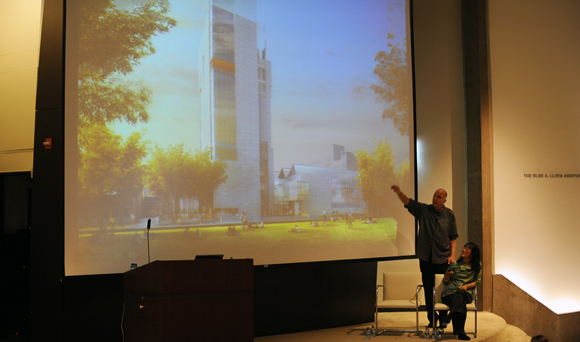
Unveiling their design for the Reva and David Logan Center for Creative and Performing Arts before an SRO crowd last Tuesday night, architects Tod Williams and Billie Tsien showed off a building that will act as both University anchor and portal. Located at 60th Street and Ingleside Avenue, the $114 million building has a planned May 2010 groundbreaking and 2012 opening.
Along with practice rooms, classrooms, studios, and a shop shared by set designers and artists, the Logan Center will have lots of public spaces: three theaters, a gallery, a glass-walled penthouse performance space, and a ground-level cafe. Designed to become a South campus landmark, the building "will let people know that the University of Chicago has a deep commitment to the arts of the present," said Dan Logan, whose family committed a $35 million gift to support the center.
Students, faculty, alumni, and friends who couldn't make it to the Law School auditorium for the unveiling could watch via live Webcast as the architects walked through slides of the building and answered questions about their design. Here are a few architectural details:
What the principals wore
Tod's loose gray shirt resembled an artist's smock; Billie's blouse was tailored and green. Within minutes, they'd both pushed up their sleeves.
Conversational style
She stayed seated, advanced the slides, and wielded the laser-pointer. He jumped up, walked around, built boxes with his hands. Both got their points across.
Their marching orders
As told to the audience by the evening's emcee, Deputy Provost for the Arts Larry Norman: "First and foremost, an integrative arts center.... It had to be a very porous building. They were told, 'It's OK if the building has a front but it can't have a back.' You're going to see a building with a lot of entryways."
Their inspirations (global)
Their inspirations (local)
LEEDing question: How green is the building?
The center will achieve a LEED (Leadership in Energy and Environmental Design) rating. Contributing to the green factor:
And the night's towering question
Is the center's tower taller than Rockefeller Chapel?
After the slide show...
Architects and audience repaired to a lobby reception where renderings of the center were on display.
Mary Ruth Yoe
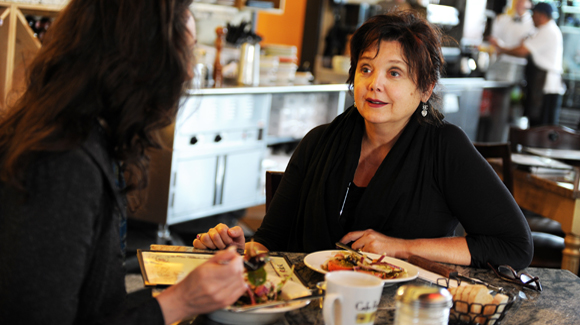
It’s a rare occasion that either of us finds a reason to cross the state line into Indiana, but the promise of good Italian cooking proved incentive enough. Luckily, the Hoosier State is closer to Chicago than we’d remembered. After a quick, cheap train ride on the South Shore Line (a 28-minute journey from Hyde Park to Hammond, Indiana, costs less than $5), we found ourselves in the hospitable hands of Karen, AM’83, MBA’89, and Mike Jesso, the husband-and-wife team behind Café Borgia.
 The Jessos had originally intended to open their café down the street from the Medici on 57th, naming their restaurant after the Italian Borgia family, historical rivals of the Medicis. When their Hyde Park plan fell through, they settled on a Lansing, Illinois, location instead and moved to nearby Munster in August 2007. But they kept the name. Ever the Chicago scholar, Karen had done her research on the Borgias, discovering that the family was known for its love of fine dining. She says her executive-chef husband even incorporated some Borgia family favorites into the modern Italian menu.
The Jessos had originally intended to open their café down the street from the Medici on 57th, naming their restaurant after the Italian Borgia family, historical rivals of the Medicis. When their Hyde Park plan fell through, they settled on a Lansing, Illinois, location instead and moved to nearby Munster in August 2007. But they kept the name. Ever the Chicago scholar, Karen had done her research on the Borgias, discovering that the family was known for its love of fine dining. She says her executive-chef husband even incorporated some Borgia family favorites into the modern Italian menu.
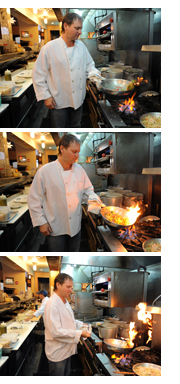 That menu led to some moments of agonizing indecision, as we wavered between prosciutto-wrapped mozzarella or mozzarella en carozza (essentially fancy mozzarella sticks) to start. We got both, each served in a pool of Chef Jesso’s tomato sauce—what Karen calls “a modern version” of the traditional sauces cooked for hours. The pesto sauce, which we tasted in the roasted red pepper pesto spread appetizer, is made from the basil plants the Jessos grow in small garden plots outside the restaurant—enough for a year's worth of pesto. Before the frost hits, they make 100 pounds of pesto, freezing it for winter.
That menu led to some moments of agonizing indecision, as we wavered between prosciutto-wrapped mozzarella or mozzarella en carozza (essentially fancy mozzarella sticks) to start. We got both, each served in a pool of Chef Jesso’s tomato sauce—what Karen calls “a modern version” of the traditional sauces cooked for hours. The pesto sauce, which we tasted in the roasted red pepper pesto spread appetizer, is made from the basil plants the Jessos grow in small garden plots outside the restaurant—enough for a year's worth of pesto. Before the frost hits, they make 100 pounds of pesto, freezing it for winter.
By the time we got to our entrees—shrimp and seashells in a tomato-vodka sauce and rigatoni with smoked chicken—we were nearly stuffed. And the tiramisu summoned us with its ladyfingers, so we decided to take most of our pasta dishes home to save room for dessert, which also included the restaurant’s signature zucotto (chocolate cake filled with white-chocolate mousse and pistachios) and rice pudding. No surprise that we left with two heavy doggie bags.
For one of us, the leftovers were sadly never to be enjoyed. The victims of a surprise office refrigerator cleaning, the leftover rigatoni and smidgen of remaining zucotto most likely ended up in the trash or—the better option—were enjoyed by the person cleaning out the fridge. Another reason to make our way back to Borgia.
Elizabeth Chan and Ruth E. Kott, AM'07
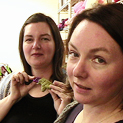
They knit; they crochet; they’re funny as hell. Sisters Kathleen, AB’84, and Sharon Kelly own Arcadia Knitting, a yarn shop in Chicago’s Uptown neighborhood. Before launching the business in 2000, Kathy applied her Chicago economics degree as a marketing consultant and Sharon, in her own words, had “a series of crap-tastic jobs.” UChiBLOGo’s Elizabeth Station stopped by the store to fondle the latest yarns and hear all about the “data-bling mitten” (pdf pattern)—what the well-accessorized geek is wearing this winter.
Tell me about the little mitten you’re wearing around your neck. Does it have a flash drive inside? How did the idea for this come about?
SHARON: I’ve been working on the editing certificate at the Graham School of the University of Chicago. My very first professor, Susan Allan, always had two or three of these data sticks on, and she referred to them as ‘the data bling.’
So she wore flash drives around her neck, but not with any knitwear?
SHARON: Not with any knitwear, no. I was on the way home from class, thinking about the knitting and the bling, and wondering, ‘Is there a way to cute these things up?’ Because I see people walking into the shop all the time; they’ve got one or two flash drives on, they’ve got their work tag—the corporate tagging, if you will. I thought, ‘Is there any way to individualize that?’ Then I sat down and said, ‘I’m going to make a little mitten for this thing.’
Who are your clients at Arcadia Knitting?
KATHY: There are the new grandmothers who used to knit years ago, and started again when they got their first grandkids. Then there are the younger people who want to do something creative and think, ‘Not everything I own should be from The Gap.’ Knitting is also a way to meet people. Our clients are single and dating; they come in with their girlfriends, take classes, and do things together, and then they mate. They’re prepared to make the baby blanket, and then they have the baby and we don’t see them for eight years.
SHARON: I’ve actually seen that cut down to five.

What about teenagers who knit?
KATHY: There have always been crafty girls.
Any men?
KATHY: Oh hell, yeah.
SHARON: There were four in yesterday. They’re looking for a mate or a partner, but they’re not necessarily looking for someone of the opposite gender.
KATHY: Knitting runs across sexual orientation. Even the tattoo artists are signaling, ‘I’m ready to mate, to pair up.’
What are you selling right now that you really like?
SHARON: We have some fabulous yarns from Karabella. We have fabulous knitting bags and supplies from della Q. We have Jade Sapphire cashmere—100 percent Mongolian cashmere, the good stuff.
KATHY: Because cashmere supply is dicey. There’s a lot of mislabeling.
SHARON: There are also a lot of bad goats. Unhealthy goats.
How has the recession affected knitting?
SHARON: I’m seeing a lot more people bring half-finished projects out of the closet. The record is 15 years. We found the sales slip.
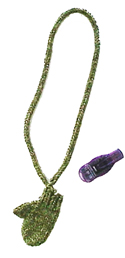
Did you learn anything practical in your college econ courses that help you run a business?
KATHY: You use the training every day. It’s the whole pushing-boundaries-and-always-testing-yourself thing. Oh, and being bossy. You can go out into the world and the world can present you with a lot of BS, but you’ve been taught to see through the BS.
SHARON: It wasn’t the degree in economics; it was that Core-class stuff of: ‘Here’s a subject, how do you study it?’ Watching her apply the University of Chicago approach to crochet and then spinning … [laughter]. She decides she’s going to conquer crochet, so she finds what are defined as, shall we say, the five core masterworks—the great books of crochet. So she sits down with the great works of crochet and her ball of yarn, reads a little from the beginning, middle, and end of each book; reads the index, cross-references, and makes her little program of study. And watching the piles of granny squares grow, I have to admit—
KATHY: That’s actually true.
Was it a good way to learn?
KATHY: Yeah, because the knowledge you gain when you realize that there is no one, standard granny-square pattern, that there are variations, then gives you the freedom when you practice the craft to do whatever the hell you want.
So, granny squares as metaphor.
KATHY: Yes.
RELATED LINKS:
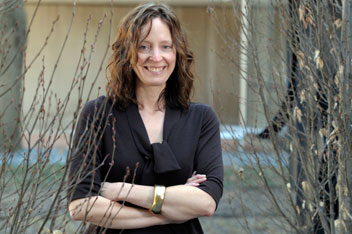 When she became the University of Chicago’s first sustainability director in November 2008, Ilsa Flanagan discovered a quick path to the professional compost heap. “I’d tell people we should have an energy policy, and they’d say, ‘If you want to lose your job in the next two months, tell people that,’” Flanagan said. “They don’t like policies at the University of Chicago.”
When she became the University of Chicago’s first sustainability director in November 2008, Ilsa Flanagan discovered a quick path to the professional compost heap. “I’d tell people we should have an energy policy, and they’d say, ‘If you want to lose your job in the next two months, tell people that,’” Flanagan said. “They don’t like policies at the University of Chicago.”
Decentralized, opinionated Chicago might not like policies, but the energy generated from its interdisciplinary cross currents offers advantages. Flanagan’s previous employer, LaSalle Bank in Chicago, had a top-down structure both in its organizational chart and in its 45-story headquarters. The University's environment is different, and so its approach to sustainability must be as well.
Within the 211-acre Hyde Park campus, 30,000 people live and work in 260 buildings. From an environmental standpoint, “it’s all about the buildings,” Flanagan said at her November 12 Gleacher Center talk on “Sustainable Organizations: Building a Framework.” The impact of those facilities is so essential to campus sustainability that former Board of Trustees chair James S. Crown donated $2.5 million this year to study their greenhouse-gas emissions and energy use and to implement efficiency upgrades.
New facilities go through the Leadership in Energy and Environmental Design (LEED)–certification process, but they do not simply follow the principles of sustainable design. The broader mandate is to make environmental practices a more—ahem—organic part of a building’s operation or a person’s daily routine. The Searle Chemistry Laboratory, for example, has a “green roof” that reduces the facility’s energy use. On an individual level, artists can conserve materials to reuse on multiple projects.
Flanagan engages academics such as economist Richard Thaler, author of Nudge, to brainstorm persuasive ways to frame the issue and subtle methods to change behavior. And behaviors have changed: Since her arrival last year the University has diverted 30 percent of its landfill waste into recycling. The word “recycle” itself has taken on an added meaning; it’s the name of the University’s new free bike-sharing program. Another initiative, SAGE (Sustainable Actions for a Greener Environment), enlists student ambassadors and others to educate people about sustainability practices.
With the range of issues she faces, Flanagan can use the help. Green construction, composting, light bulbs, double-sided printing—the subjects that cross her desk range from the big picture to the pixel. Then there are the product pitches, proof that the word “green” does not apply to environmental concerns alone. “I probably get two to three calls from vendors daily,” Flanagan noted, “saying, ‘I’ve got the best cubicle material, the best carpet, the best whatever.’
Determining what’s best for the University of Chicago remains an ongoing discussion, which she intends to continue until the idea of a sustainability director becomes an anachronism. “You want to work yourself out of a job,” Flanagan said—not that she would make that a policy.
Jason Kelly
This page contains all entries posted to UChiBLOGo in November 2009. They are listed from oldest to newest.
October 2009 is the previous archive.
December 2009 is the next archive.
Many more can be found on the main index page or by looking through the archives.